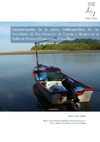Identificador persistente para citar o vincular este elemento:
https://accedacris.ulpgc.es/jspui/handle/10553/74739
| Title: | Caracterización de la pesca multiespecífica de las localidades de San Francisco de Coyote y Bejudo en el Golfo de Nicoya (Guanacaste, Costa Rica) | Other Titles: | Characterizacion of the multispecific fishery of the populations of San Francisco de Coyote and Bejudo, in the Gulf of Nicoya (Guanacaste, Costa Rica) | Authors: | Díez Galerón, Patricia | Director: | Castro Hernández, José Juan | UNESCO Clasification: | 510208 Pesca | Keywords: | Costa Rica Artisanal fishery Multispecific fishery Data poor fishery Bottom-longline, et al |
Issue Date: | 2017 | Abstract: | Tradicionalmente la gestión pesquera de Costa Rica ha sido basada en vedas, disminución de licencias y prohibiciones, junto con la creación de Áreas Marinas Protegidas (AMPs). En este trabajo se manifiesta la necesidad de tener en cuenta el conocimiento tradicional de las poblaciones de pescadores, para cubrir parcialmente los grandes vacíos en información pesquera, y utilizarlo como medio para avanzar hacia estrategias de conservación marinas más integrales.
El presente trabajo tiene por objetivo caracterizar la pesquería artesanal desarrollada por las flotas con base en las poblaciones de San Francisco de Coyote y Bejuco, en el Golfo de Nicoya entre 2007 y 2017. Estas comunidades cuentan con una flota de 32 embarcaciones que dedican sus esfuerzos a la pesca de peces pelágicos y demersales mediante palangres de fondo, trasmallos y liñas de mano, siendo el palangre el sistema más usado. Las principales especies objetivo son Lutjanus guttatus, que representa el 56% de las capturas, L. argentiventris, con el 7%, e Hyporthodus acanthistius, con solo el 2% del total desembarcado. Las culebras (Ophichthus spp.) son el segundo grupo de peces más capturado (9%), a pesar de no tener valor comercial. Los datos de frecuencias de tallas de L. guttatus, corroboran los testimonios de los pescadores, ya que confirman que los pargos son significativamente más pequeños y, por tanto, necesitan realizar un mayor número de salidas (de 5 a 6 días por semana). Traditionally, fisheries management in Costa Rica has been based on bans, reduction of licenses and prohibitions, with the creation of Marine Protected Areas (MPAs). This work shows the need to take into account the traditional knowledge of the fishing populations, to partially cover the large gaps in fishing information, and use it as a means to move towards more comprehensive marine conservation strategies. The objective of this work is to characterize the artisanal fishery developed by the fleets based on San Francisco de Coyote and Bejuco, in the Gulf of Nicoya, between 2007 and 2017. These communities have a fleet of 32 boat that dedicate their efforts to fishing of pelagic and demersal fish by bottom-longlines, gillnets, and hand-lines, being the bottom-longline the most used system. The main target species are Lutjanus guttatus, which represents 56% of the catches, L. argentiventris, with 7%, and Hyporthodus acanthistius, with only 2% of the total landed. Snakes (Ophichthus spp.) are the second most caught group of fish (9%), despite having no commercial value. The size frequency data of L. guttatus, corroborate the testimonies of the fishermen, since they confirm that the snappers are significantly smaller and, therefore, they need to make a greater number of times to fish (5-6 days per week). |
Department: | Biología | Faculty: | Facultad de Ciencias del Mar | Degree: | Máster Universitario en Gestión Sostenible de Recursos Pesqueros | URI: | https://accedacris.ulpgc.es/handle/10553/74739 |
| Appears in Collections: | Trabajo final de máster |
En el caso de que no encuentre el documento puede ser debido a que el centro o las/os autoras/es no autorizan su publicación. Si tiene verdadero interés en el contenido del mismo, puede dirigirse al director/a o directores/as del trabajo cuyos datos encontrará más arriba.
Show full item recordPage view(s)
156
checked on Dec 7, 2024
Download(s)
32
checked on Dec 7, 2024
Google ScholarTM
Check
Share
Export metadata
Items in accedaCRIS are protected by copyright, with all rights reserved, unless otherwise indicated.
